Model M833
FEATURES
M833 is a unique high-aperture double dispersive monochromator-spectrograph whose compact design combines high spectral resolution intrinsic for long-focus instruments and extremely low stray light which is an essential requirement for Raman spectroscopy, as well as for any other low-light-level applications.
EXTREMELY LOW STRAY LIGHT
THE COMPACT LONG-FOCUS INSTRUMENT (F=833MM) WITH THE UNIQUE HIGH APERTURE (F# 1:5.5)
THE M833I IN THE IMAGING MODE
THREE PAIRS OF GRATINGS
TWO INPUT AND TWO OUTPUT PORTS
FULL COMPUTER CONTROL
THE SOLARLS.LAB
DLL AND/OR VI PROGRAM MODULES
DESCRIPTION
Extremely low stray light allows the multi-element detector to simultaneously acquire both Stokes and Anti-Stokes components at the distance up to 20 cm-1 from the excitation line (1200 l/mm gratings) without using any Notch or Edge-filters.
The compact long-focus instrument (f=833mm) with the unique high aperture (F# 1:5.5) enables solving tasks, that demand high spectral resolution, yet occupies little space in your laboratory and, furthermore, is mobile.
The M833i in the Imaging mode provides absolute astigmatism compensation and high spatial resolution along the exit slit, meanwhile preserving the ideal line quality.
Three pairs of gratings (number of lines per mm and blaze wavelength are tailored to the Customer’s requirements) are supplied in a standard set and ensure the widest range of applications.
Two input and two output ports can be completed with the full set of accessories manufactured by SOLAR LS: standard and crossed entrance slits, order separating filter wheels, aperture matching units and optical fibers, CCD detectors and adapters for them.
Full computer control: slits, diffraction grating turrets and filter wheels, input/output port switching is controlled by the intelligent and easy-to-use software.
The SolarLS.LAB software provides automated control over the M833 and its detectors. It allows stitching spectra obtained by several diffraction grating scans in order to get a panoramic spectrum. Many possibilities of spectra processing and analysis are provided as well.
At your request, DLL and/or VI program modules are supplied for controlling the instrument via the customised software or LabVIEW.
INSTRUMENT CONFIGURATION
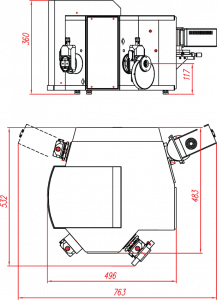
The M833 comprises either one or two input and output ports. Input port may hold either a standard entrance slit, or a crossed entrance slit (optionally). All the spectral slits are automated; their width is adjusted by the instrument software. The slit design also contains a microscrew, which provides the possibility to manually adjust the opening width of the slit knives.
The standard M833 version comprises three pairs of diffraction gratings mounted on two turrets. Since the M833 implements separate control for scanning and grating changing, each diffraction grating, when scanning the spectrum, rotates around an axis passing through its center. This allows to bring your real optical system close to the initial optical design and to provide its highest optical quality.
The standard optics comprises spherical and flat mirrors with Al+MgF2 coating optimized for high UV efficiency. Optionally the M833 may contain optics with Al+SiO2 or gold coating for high efficiency in the infrared spectral range.
The M833 output ports may hold either two exit slits, or one exit slit and detector, or two detectors concurrently.
Direct (axial) and lateral (radial) output ports operate alternately. Switching between the output ports is effected by the software with the use of the swinging mirror, which in its operating position directs light to the lateral (radial) output port. The instrument is also available with one output (axial) port. If the radial output port is not used, it is plugged.
The M833 exit slit has 4 mounting holes M2.5 that allow you fixing your own detector to the slit housing, if necessary. Location of mounting holes is shown in the figure below.
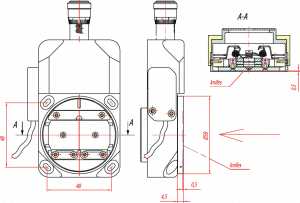
Note: To avoid a breakdown of the slit mechanism it is prohibited to fix any units weighing more than 1 kg to the slit housing!
| OPTICAL SCHEME | OPTIMIZED CZERNY-TURNER WITH DOUBLE DISPERSION | |||||
| — Spectral range | — Typical 180-4800 nm (refer to the specifications below) — Up to 40µm when the appropriate gratings are used | |||||
| — Imaging | Option. Available for the lateral output port | |||||
| — Optical ports | 2 inputs and two outputs | |||||
| — F/Number | 1:5.5 | |||||
| — Effective focal length, mm | 833 | |||||
| — Flat field, mm | 30 х 10 | |||||
| Diffraction gratings | 70х70х10mm, automated turret with three pairs of gratings from the list below1) | |||||
| — Grooves/mm | 2400 | 1800 | 1200 | 900 | 600 | 300 |
| — Blaze wavelength, nm | 225 | 400 | 600 | 600 | 1000 | 2000 |
| — Effective spectral range 2) | 190-600 | 253-800 | 380-1200 | 506-1600 | 760-2400 | 1500-4800 |
| — Mechanical scanning range | 0-640 | 0-850 | 0-1280 | 0-1710 | 0-2560 | 0-5120 |
| — Reciprocal liner dispersion on the edges of the spectral range, nm/mm | 0.46-0.27 | 0.61-0.36 | 0.92-0.54 | 1.22-0.72 | 1.84-1.08 | 3.68-2.16 |
| — Average value, nm/mm | 0.39 | 0.52 | 0.78 | 1.04 | 1.56 | 3.12 |
| — Output bandwidth on the edges of the spectral range, nm | 13.3-7.9 | 19.95-11.8 | 26.6-15.8 | 39.9-23.7 | 23.5-13.8 | 47.0-27.6 |
| — Average value, nm | 11.283) | 16.923) | 22.573) | 33.843) | 205) | 405) |
| — Spectral resolution on the edges of the spectral range, nm | 0.015-0.009 | 0.02-0.012 | 0.03-0.017 | 0.04-0.024 | 0.12-0.07 | 0.24-0.14 |
| — Average value, nm | 0.0123)0.0244) | 0.0163)0.0334) | 0.0243)0.0484) | 0.0323)0.0664) | 0.15) | 0.25) |
| — Average value, cm-1 | 0.83)1.564) | 0.573)1.174) | 0.43)0.784) | 0.33)0.64) | 0.435) | 0.25) |
| — Wavelength tuning accuracy, nm | ±0.03 | ±0.04 | ±0.06 | ±0.08 | ±0.12 | ±0.24 |
| — Wavelength tuning repeatability, nm | ±0.006 | ±0.008 | ±0.012 | ±0.016 | ±0.024 | ±0.048 |
| — Step of grating rotation, nm | 0.0017 | 0.0023 | 0.0035 | 0.0046 | 0.007 | 0.014 |
| — Scanning rate, nm/s | 5.3 | 7 | 10.5 | 14 | 23 | 42 |
| Entrance/Exit slits | Automatic and manual adjustment | |||||
| — Slit width, mm | 0 – 2 | |||||
| — Slit height, mm | 12 | |||||
| — Parallelism, µm | ± 1 | |||||
| — Step size, µm | 0.5 | |||||
| — Precision, µm | ± 10 | |||||
| Shutter6) | Integrated, software-controlled | |||||
| Filter wheel | Automatic and manual adjustment | |||||
| — Max number of filters | 8 | |||||
| — Filter size, mm | 20 | |||||
| — Light aperture, mm | 18 | |||||
| Computer interface | Full Speed USB | |||||
| Dimensions, mm | 496 x 483 x 360 | |||||
| Weight, kg | 53 | |||||
1) A set of installed diffraction gratings is confirmed while placing the order. Upon your request, diffraction gratings with another number of grooves per mm and another blaze wavelength can be used.
2) Effective spectral range of the grating covers the range with diffraction efficiency 40% of the peak efficiency
3) For detector with 8 um pixel size and 29.1 mm active area (resolution is 4 pixels)
4) For detector with 25 um pixel size and 25.6 mm active area (resolution is 2.5 pixels)
5) For detector with 25 um pixel size and 12.8 mm (resolution is 2.5 pixels).
6) Designed to measure background automatically and to protect a detector against zero-order light
The M833 monochromator-spectrograph has a wide range of options and accessories that provide efficient light collection from the sample located at a finite distance and at infinity, delivering light to the monochromator with and without an optical fiber, effective aperture matching of the optical fiber and monochromator.
Order Separating Filters Wheels
Aperture Matching Adapters
Condensers for collecting light into the fiber
Condensers for collecting light into the monochromator
Crossed Entrance Slit (optionally installed instead of the Standard Entrance Slit)
Optical Fibers
Adapters for attaching CCD detectors
CCD detectors
Cassegrain lenses
All exit slits are equipped with precision focusing devices; and detector adapters allow easy detector focusing. The detector adapter of the long-focus M833 monochromator-spectrograph allows changing the slope of detector plane relative to the optical bench.
Cassegrain lenses allow collecting light from objects located at a distance of 3.5m to infinity.
Adapters PS-2 and PS-3 are designed for the collection of light from a closely located sample and its effective input into an optical fiber. PS-2 features high transmittance in the UV range, while PS-3 has the possibility of installing an edge filter.
Contact a SOLAR LS specialist to select the complete set of your monochromator-spectrograph that meets the requirements for your instrument complex in the best way.
MULTI-CHANNEL CCD DETECTORS
| MULTICHANNEL CCD DETECTORS BY ANDOR TECHNOLOGY TM | |
| iVac Series, Spectroscopic CCD | DR 324B-FI model, front-illuminated CCD sensor, UltraVacTM thermo-electric cooling down to -60°C, spectral range 400-1000nm, 1650*200pixels, pixel size 16*16µm, image area 26.4mm * 3.2mm, 16 bits digitisation |
| iDus Series, Spectroscopic CCD | DV 401A-BV model, back-illuminated CCD sensor, UltraVacTM thermo-electric cooling down to -70°C, spectral range 200-1100nm, 1024*127pixels, pixel size 26*26µm, image area 26.6mm * 3.6mm, 16 bits digitisation |
| DU 401A-BV model, back-illuminated CCD sensor, UltraVacTM thermo-electric cooling down to -100°C, spectral range 200-1100nm, 1024*127pixels, pixel size 26*26µm, image area 26.6mm * 3.6mm, 16 bits digitisation. | |
| Newton Series, EMCCD | DU970P-FI model (*), front-illuminated EMCCD sensor, UltraVacTM thermo-electric cooling down to -100°C, spectral range 400-1000nm, 1600*200pixels, pixel size 16*16µm, dual output amplifier, crop mode, Variable readout speed up to 3MHz, 16 bits digitisation. |
| DU970P-BV model (*), back-illuminated EMCCD sensor, UltraVacTM thermo-electric cooling down to -100°C, spectral range 200-1000nm, 1600*200pixels, pixel size 16*16µm, dual output amplifier, crop mode, Variable readout speed up to 3MHz, 16 bits digitisation | |
| iStar Series, Gated iCCD | DH320T-25U-03 model (*), Ultra Fast Gated Intensified CCD Camera, spectral range 200-900nm, 124*256 CCD 100% Fill Factor, 25mm tube, Gen2 Multialkali S20 Photocathode, P43 phosphor Multi-Mhz Readout Speeds, Integrated Digital Delay Generator, 3 ns Crop Mode sensor, Photocathode dry gas purge port, USB data interface. |
(*) other models are supplied upon request
| TWO-DIMENSIONAL HAMAMATSU ARRAYS FOR THE 200-1100NM RANGE | |
| UC-16H7306, Spectroscopic CCD | S7030-1006 sensor, non-cooled, spectral range 200-1100nm, 1024×64 pixels, pixel size 24×24µm, image area 24.6×1.4mm, 16 bit digitization |
| UC-16H7307, Spectroscopic CCD | S7030-1007 sensor, non-cooled, spectral range 200-1100nm, 1024×128 pixels, pixel size 24×24µm, image area 24.6×2.9mm, 16 bit digitization |
| UC-16H7316, Spectroscopic CCD | S7031-1006 back-illuminated sensor, TE cooling –10°C, spectral range 200-1100nm, 1024×64 pixels, pixel size 24×24µm, image area 24.6×1.4mm, 16 bit digitization |
| UC-16H7317, Spectroscopic CCD | S7031-1007 back-illuminated sensor, TE cooling –10°C, spectral range 200-1100nm, 1024×128 pixels, pixel size 24×24µm, image area 24.6×2.9mm, 16 bit digitization |
| UC-16H7318, Spectroscopic CCD | S7031-1008 back-illuminated sensor, TE cooling –10°C, spectral range 200-1100nm, 1024×256 pixels, pixel size 24×24 µm, image area 24.6 x 6.1mm, 16 bit digitization |
| U2C-16H10426, Spectroscopic CCD | S10420-1106-01 back-illuminated sensor, non-cooled, spectral range 200-1100nm, 2068х70 pixels, pixel size 14х14 µm, image area 28.672х0.896mm, 16 bit digitization |
| U2C-16H11516, Spectroscopic CCD | S11510-1106 back-illuminated sensor, non-cooled, spectral range 200-1100nm, 2068х70 pixels, pixel size 14х14 µm, image area 28,672х0,896mm, 16 bit digitization |
| U2C-16H11850, Spectroscopic CCD | S11850 back-illuminated sensor, TE cooling 5°С, , spectral range 200-1200nm, 2068х70 pixels, pixel size 14х14 µm, image area 28,672х0,896mm, 16 bit digitization |
| U2C-16H101409, Spectroscopic CCD | S10140-1109 back-illuminated sensor, non-cooled, , spectral range 200-1100nm, 2068х70 pixels, pixel size 14х14 µm, image area 28,672х0,896mm, 16 bit digitization |
| U2C-16H101419, Spectroscopic CCD | S10141-1109 back-illuminated sensor, TE cooling -10°C, , spectral range 200-1200nm, 2068х512 pixels, pixel size 12х12 µm, image area 24,576х6,072mm, 16 bit digitization |
| LINEAR INGAAS HAMAMATSU SENSORS FOR NIR-RANGE 900-1700NM (UP TO 2600NM) | |
| UC-16H904, InGaAs sensor | G9204-512D image sensor, spectral range 0.9-1.7µm, non-cooled, 512 pixels, pixel size 25×500µm, image area 12.8×0.5mm, 16 bit digitization |
| UC-16H912, InGaAs sensor | G9212-512S image sensor, InGaAs, spectral range 0.9-1.7µm, TE cooling –10°C, 512 pixels, pixel size 25×250µm, image area 12.8×0.25mm, 16 bit digitization |
| UC-16H914, InGaAs sensor | G9214-512S image sensor, InGaAs, spectral range 0.9-1.7µm, TE cooling –10°C, 512 pixels, pixel size 25×500µm, image area 12.8×0.5mm, 16 bit digitization |
| UC-16H908, InGaAs sensor | G9208-256W image sensor, InGaAs, spectral range 0.9-2.6µm, TE cooling –20°C, 256 pixels, pixel size 50×250µm, image area 12.8×0.25mm, 16 bit digitization |
| LINEAR NON-COOLED SENSORS FOR THE 200-1100NM RANGE | |
| UC-12T3 | TCD1304 image sensor, spectral range 190-1100nm, non-cooled, 3648 pixels, pixel width 8µm, image area 29.18×0.2mm, 14 bit digitization |
| UC-12T2 | TCD1205 image sensor, spectral range 200-1100nm, non-cooled, 2048 pixels, pixel width 14µm, image area 28.672×0.2mm,14 bit digitization |
| U2C-14H13496 | S13496 image sensor, spectral range 200-1000nm, non-cooled, 4096 pixels, pixel size 7 µm, 14 bit digitization |
| U2C-14H11639 | S11639-01 image sensor, spectral range 200-1000nm, non-cooled, 2048 pixels, pixel size 14 µm, 14 bit digitization |
The M833 is a unique double dispersive monochromator-spectrograph consisting of two Czerny-Turner monochromators. Its key difference from any conventional double monochromator is that the M833 features the 30mmx10mm flat field and allows attaching not only a single detector (PMT), but also a multichannel array for simultaneous detection of a wide spectrum range.

High-Resolution Automated Raman Spectrograph Model M833
This feature is implemented by replacing the camera mirror of the first monochromator and the collimator mirror of the second monochromator with a specially designed optical matching system.
In addition, the optical matching system performs the following functions:
Provides an optical coupling between the two monochromators-spectrographs located one above the other in a two-level optical design. Thus, we achieve compactness and mobility of the long-focus monochromator-spectrograph M833.
Ensures the complete coma compensation for any wavelength in the center of the exit slit (or in the center of a multichannel array). As a result the M833 does not have the spectral region of primary coma compensation. The M833 demonstrates its unique spectral resolution and high spectral line quality for any wavelength within the spectral range of gratings diffraction efficiency.
The M833 optical layout and design completely exclude the possibility of re-reflections in specified spectral regions of the device operation, and reduce stray light by two orders of magnitude as compared to single monochromators having similar dispersion/focal length.
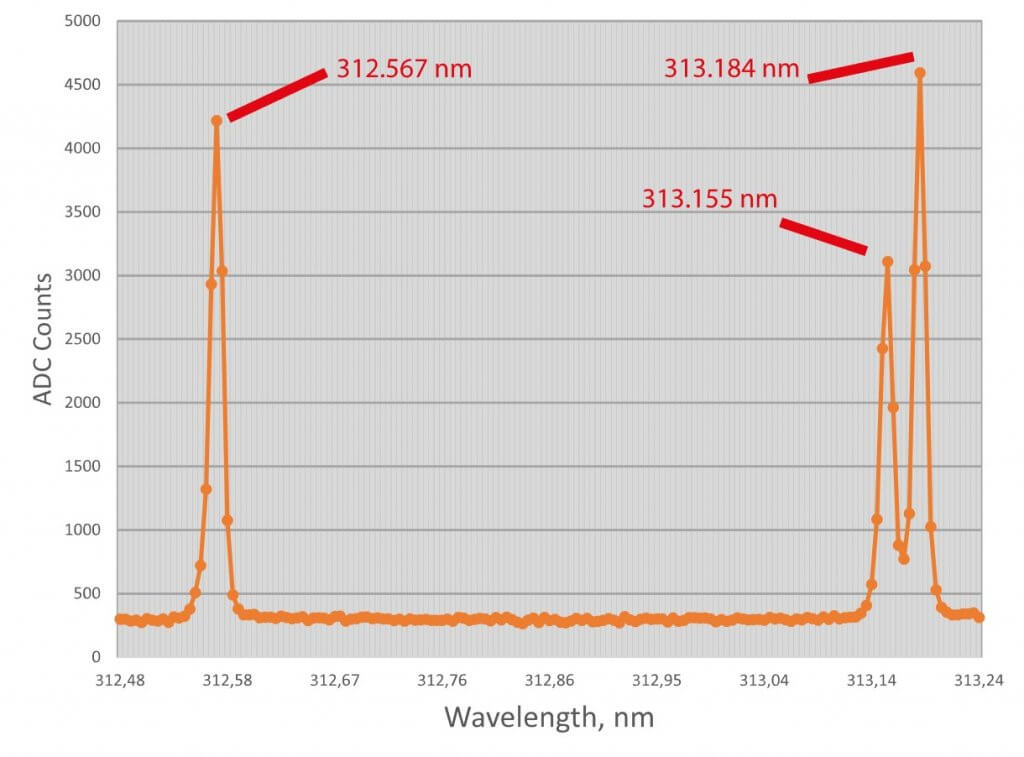
Mercury lamp lines 312.567 nm, 313.155 nm, 313.184 nm registered with the M833 and diffraction grating 1800 gr/mm demonstrate high optical quality of the instrument
ASTIGMATISM COMPENSATION (IMAGING OPTION)
Astigmatism compensation (IMAGING option) is a frequently used and popular M833 option. In case of the fiber input the IMAGING allows to effectively collect Raman signal to a height-limited detector.
The M833 astigmatism compensator is a cylindrical mirror installed at the output of the M833 optical bench instead of a flat swinging mirror directing light to the lateral (radial) port. Thus, astigmatism is usually compensated at the lateral output port of the M833, while the axial port configuration remains standard.
In general, astigmatism is common to all spectral instruments; this is a phenomenon when the point on the entrance slit is displayed as a vertical segment in the image plane. The M833 astigmatic segment is 7.7mm in the center of the flat field, and respectively 7.4mm and 8.2mm at the edges of the field. Astigmatism does not usually impair the instrument resolution, but, depending on the height of the detector used, can affect the overall sensitivity of the system.
Astigmatism correction is imperative in the multichannel spectroscopy, in case you need to adequately convey the illumination distribution along the slit, as well as when using spectrographs with multichannel arrays in the 2D-image mode (Imaging).
Introducing the astigmatism compensator in the optical scheme allows correcting astigmatism in the exit slit plane to the value of about 50mm. This fact must be considered when calculating the expected optical resolution of the M833 with a specific diffraction grating. Astigmatism compensation also affects the vertical magnification of the M833:
| M833 MAGNIFICATION | HORIZONTAL MAGNIFICATION | VERTICAL MAGNIFICATION |
| without astigmatism compensation (Standard mode) | 1,08 | 1,08 |
| with astigmatism compensation (Imaging mode) | 1,08 | 0,8 |
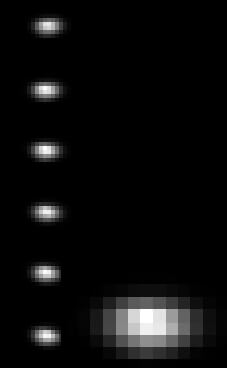
2D-images of the fiber bundle consisting of multiple 100µm fibers acquired with the M833 demonstrate high Imaging capabilities of the instrument. The M833 was equipped with iVac Andor CCD camera (16×16 µm pixel size)
SPECTRA ACQUIRED WITH THE M833
Raman scattering spectra obtained with M833i (with 1200 l/mm diffraction gratings, with 532 nm 10 mW excitation single-mode laser) demonstrate high capabilities of the device. Spectra were registered with cooled image sensor Hamamatsu S7031-1006 (pixel size 24 x 24 µm, sensor size 24.6 x 1.4 mm, ADC 16 bit, cooling -100°C) in Binning mode.
The set-up for registration of Raman scattering is shown in Figure 3.
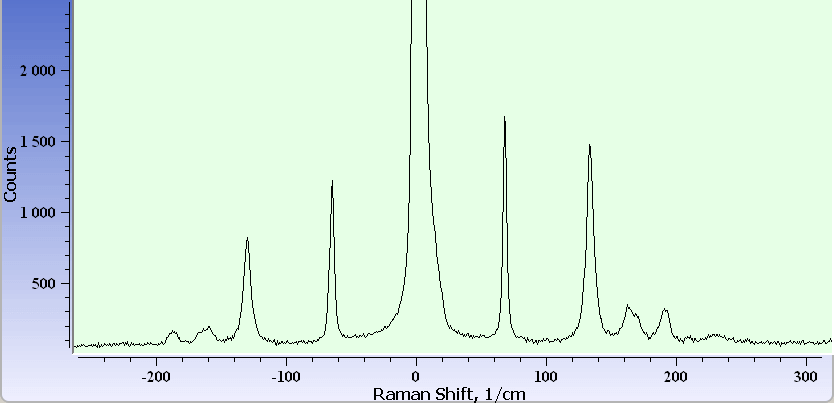
Figure 1. Raman scattering spectrum for paratellurite crystal TeO2. М833 is a unique spectrograph that allows to view on the CCD both Stokes and anti-Stokes lines at 20 cm-1 apart from the excitation line.
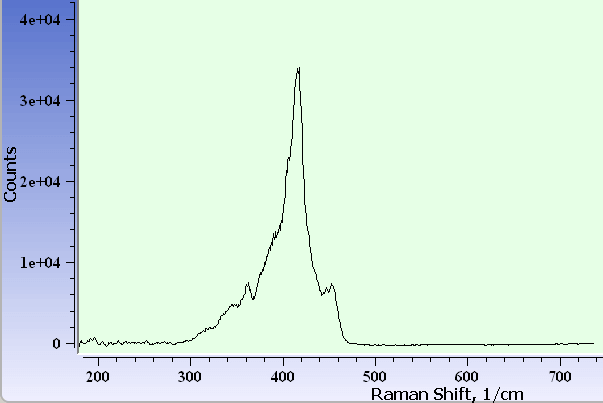
Figure 2. Raman scattering spectrum for the single acrylic fiber. Representative peaks are obtained with range 300..480 cm-1 with maximum at 405 cm-1.
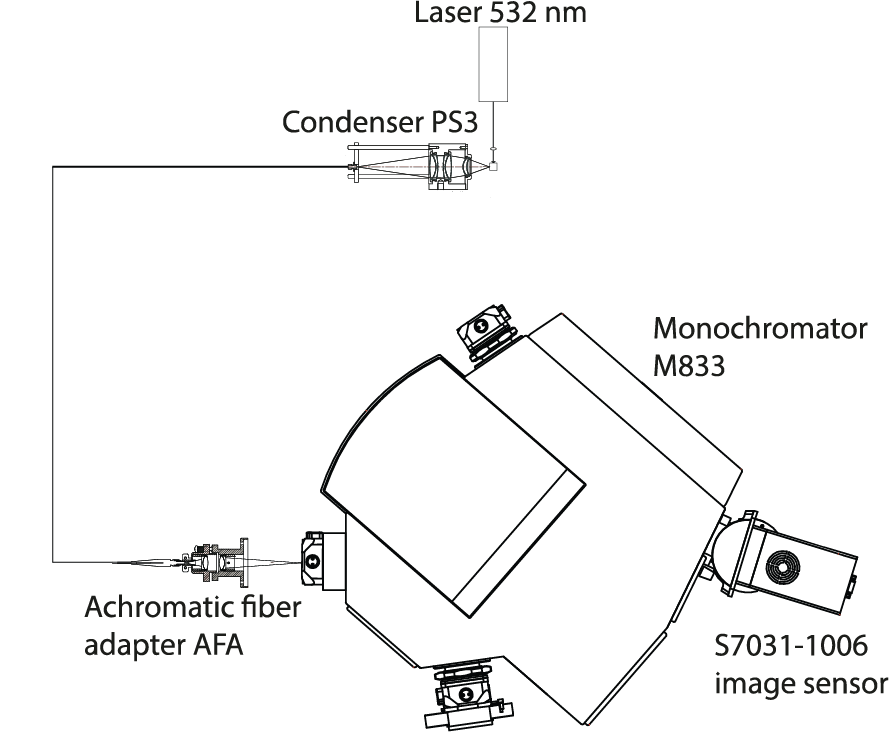
Figure 3. The set-up for registration of Raman scattering with M833.
The registration was carried out at 90° to the excitation beam. The wide-aperture condenser PS-3, an optical fiber with a diameter of 600 μm and an achromatic AFA adapter to match the apertures of the optical fiber and the monochromator – formed the light collecting system.
Raman Spectroscopy
Emission and Fluorescence Spectroscopy
Analytical Tasks Demanding High Resolution in the Range from UV to IR
Multi-Channel Spectroscopy
SOLARLS的所有資訊來自SOLARLS網頁,所有版權歸SOLARLS,繁體字版權屬安均科技。